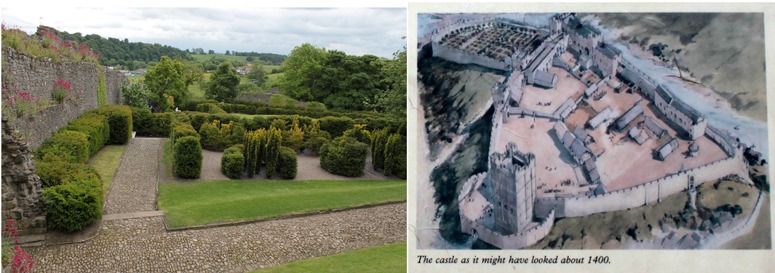- Richmond Castle garden
A summer of visiting English gardens and today’s visit to Restoration House and Garden in Rochester set me thinking about historic gardens – and reminded me to take a closer look at the 2007 English Heritage Handbook on The management and maintenance of historic parks, gardens and landscapes. It is an admirable book, well written and illustrated, but it is not the book which historic gardens most needed, because the emphasis is so much more on the technicalities of managing historic gardens than on the the strategic questions of what, why, when and where. To draw a military analogy, it is a book for quarter-masters – not a book on generalship. Also, and understandably, it offers only praise for the work of English Heritage on historic gardens. There is no clearer illustration of this point than the chart (p.47) of Job Titles and Garden Staff Roles. The highest position on the chart is Head Gardener/Garden Curator/Garden Manager and his/her qualifications are described as “M.Hort (RHS), Degree, Botanic Garden Diploma, HND or equivalents + 7 years experience’. The next column summarizes the necessary skills as ‘specialist technical skills and ability. Proven management and policy-making ability’. There is no mention of the two other essential skill-sets for managing a historic garden: historical knowledge and design judgment. It is like putting builders in charge of historic buildings, in full disregard for the need for historical knowledge and design judgment relating to architecture. Lets hope the book goes to a second edition and that this gap is filled. Meantime, we offer readers the Gardenvisit.com notes and guides to Historic Garden Restoration and and Garden Heritage Conservation.
English Heritage’s strategic weakness in garden conservation is illustrated by their work at Hampton Court and Kenilworth Castle. The handbook boasts of English Heritage’s Contemporary Heritage Garden Scheme – which I regard as almost entirely misconceived. ‘Contemporary Heritage’ is within an ace of an oxymoron – and why should they be building contemporary gardens in the precincts of great historic buildings, like Richmond Castle? To attract visitors? To give proof of their trendy tendencies? The scheme should go for scrappage.
Photo Notes: (1) the top photo shows Richmond Castle with a ‘contemporary heritage’ topiary garden (left photo) and a sensible picture of a fifteenth century orchard-vegetable garden on the English Heritage sign (top left corner of right photo) (2) the left and right photos, below, show two additional views of the ‘contemporary heritage’ garden.



I tend to disagree. if the garden had been plonked there a 100 years ago by the duke of xxxx no one would bat an eye lid if its EH or the NT then EEK!!
If historic buildings and gardens were managed in the past as they are today then nothing would have changed. we would have no Chatsworth as the family would never have got planning permission to alter the original Elizabethan house.
I appreciate that we need protection but we need to allow for growth.
my view of gardens is very simple. do I like it? does it make me feel good? Historical accuracy? ok but its not the be all and end all. everything changes.
Where I would agree is when EH won’t allow others to alter for historical accuracy!!
Pete, I agree about it being normal and natural for gardens to change and for historic gardens, I think Geoffrey Jellicoe had the best idea: Creative Conservation. See http://www.gardenvisit.com/history_theory/garden_landscape_design_articles/historic_heritage_restoration/creative_conservation_jellicoe_geoffrey
But you must have a talented designer in charge of the garden to risk such a policy!
I visited the National Trust’s Standen at the weekend and was impressed by the way the residents are involved with the house and the garden. It is a good way of managing a historic property. But the quality of the planting design in the garden is C-.
meant to add.
you ask why they “should build contemporary gardens at historic sites”. The answer surely is why not? Of course a well planned and designed garden is the preference. A fine modern garden gives as much pleasure as any historic garden. Admittedly what consitutes a fine modern garden may be harder thing to agree. If the garden at Lullingstone is a fine modern garden then I’ll despair now.
Yes and no. If the historic site is dull and nothing is known about its past, then yes: by all means make something good. But at Richmond Castle (1) English Heritage have a pretty good idea what used to be there: a castle garden used mainly for growing fruit and vegetables (2) I know of no example in England where a fair attempt at re-creating a castle garden has been made, and so I think the re-creation should take precedence over having a bit of fun.
well that’s a point I can’t argue with !
if I’m honest I’d like to see some good examples of pre-capability gardens.
One of the reasons I like Westbury Court Garden is that it’s so different from anywhere else.
I suspect there are more (badly) re-created Roman gardens in Britain than re-created Medieval Gardens. Readers help welcome on this point! Re medieval gardens, I know of Queen Eleanor’s Garden in Winchester and Prebendal Manor and Mount Grace Priory in Yorkshire. Birmingham Botanical Garden have small and poor examples of re-created Roman and medieval gardens.
A garden within an historic site should be as accurate historically as the restoration of the building. Therefore most central areas of castles would not be attractive visually (or in gardening terms) as they were for livestock and the drilling of the soldiery and the protection of the villagers. Pleasure gardens became possible only when siege was less likely and would have been small.
English Heritage should decide whether they want to display the buildings and their sites as nearly accurately as possible or whether they want to create atttractive gardens (of whatever period) set against historic ruins. In this last case the ancient walls become merely the backdrop to the garden.